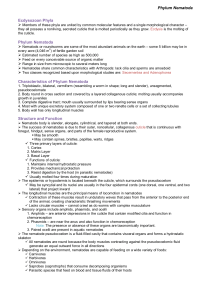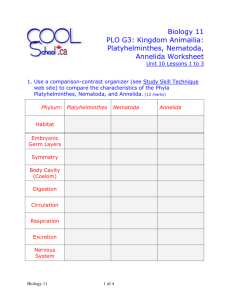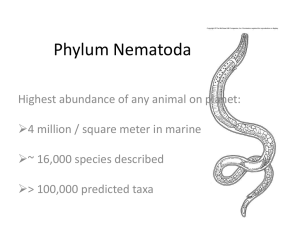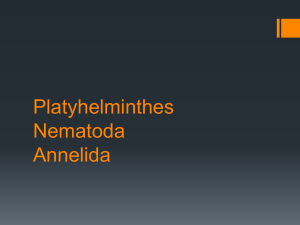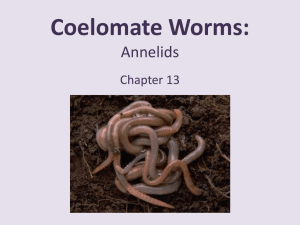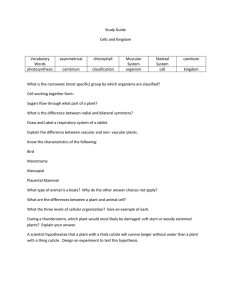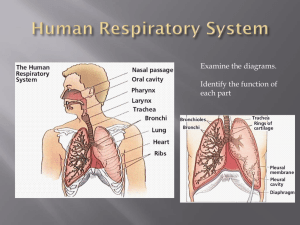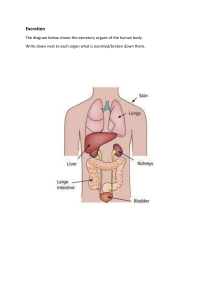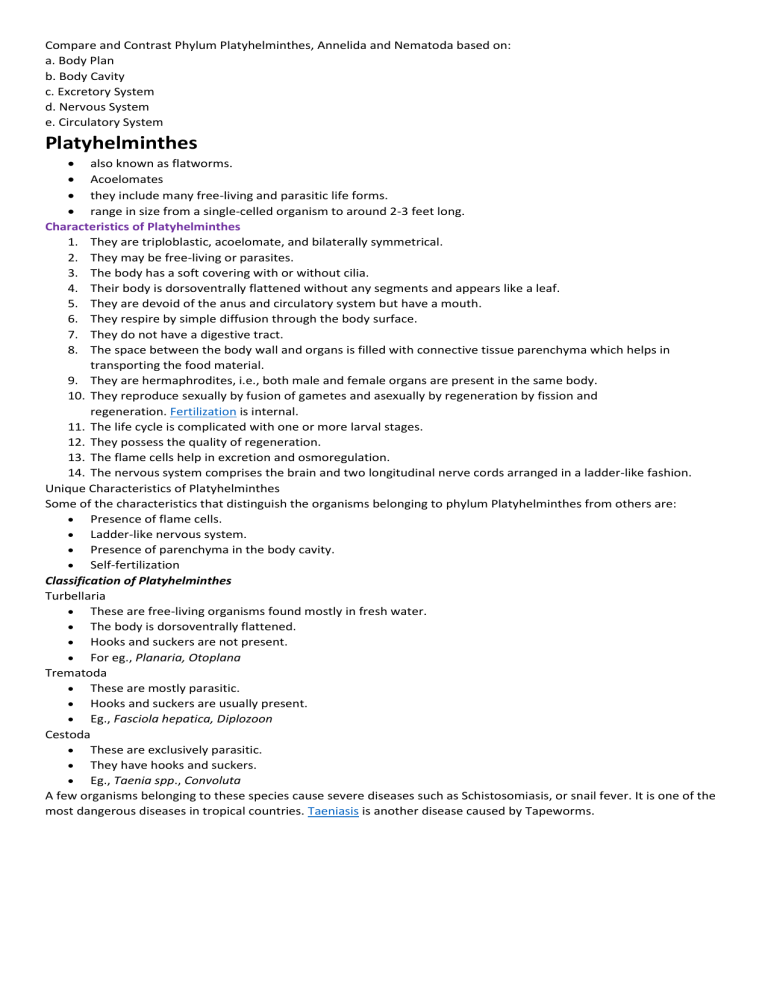
Compare and Contrast Phylum Platyhelminthes, Annelida and Nematoda based on: a. Body Plan b. Body Cavity c. Excretory System d. Nervous System e. Circulatory System Platyhelminthes also known as flatworms. Acoelomates they include many free-living and parasitic life forms. range in size from a single-celled organism to around 2-3 feet long. Characteristics of Platyhelminthes 1. They are triploblastic, acoelomate, and bilaterally symmetrical. 2. They may be free-living or parasites. 3. The body has a soft covering with or without cilia. 4. Their body is dorsoventrally flattened without any segments and appears like a leaf. 5. They are devoid of the anus and circulatory system but have a mouth. 6. They respire by simple diffusion through the body surface. 7. They do not have a digestive tract. 8. The space between the body wall and organs is filled with connective tissue parenchyma which helps in transporting the food material. 9. They are hermaphrodites, i.e., both male and female organs are present in the same body. 10. They reproduce sexually by fusion of gametes and asexually by regeneration by fission and regeneration. Fertilization is internal. 11. The life cycle is complicated with one or more larval stages. 12. They possess the quality of regeneration. 13. The flame cells help in excretion and osmoregulation. 14. The nervous system comprises the brain and two longitudinal nerve cords arranged in a ladder-like fashion. Unique Characteristics of Platyhelminthes Some of the characteristics that distinguish the organisms belonging to phylum Platyhelminthes from others are: Presence of flame cells. Ladder-like nervous system. Presence of parenchyma in the body cavity. Self-fertilization Classification of Platyhelminthes Turbellaria These are free-living organisms found mostly in fresh water. The body is dorsoventrally flattened. Hooks and suckers are not present. For eg., Planaria, Otoplana Trematoda These are mostly parasitic. Hooks and suckers are usually present. Eg., Fasciola hepatica, Diplozoon Cestoda These are exclusively parasitic. They have hooks and suckers. Eg., Taenia spp., Convoluta A few organisms belonging to these species cause severe diseases such as Schistosomiasis, or snail fever. It is one of the most dangerous diseases in tropical countries. Taeniasis is another disease caused by Tapeworms. Nematoda The organisms belonging to the phylum Nematoda are also known as “roundworms”. There are 28000 species of Nematoda identified till date. They are unsegmented vermiform animals. The epidermis has dorsal and ventral nerve cords. The Nematodes present in the soil feed on the bacteria, fungi, and other nematodes, and play an important role in nutrient recycling. They also attack the insects and control the pests. However, they cause severe damage to plants. They feed on the plant roots and reduce the nutrient uptake and stress tolerance of the plant. A spadeful of soil contains numerous Nematodes. They cause diseases such as Ascariasis, Trichuriasis, Hookworm, Enterobiasis, Filariasis, and Angiostrongyliasis in humans. They are characterized and categorized in the following ways. Characteristics of Nematoda Following are the important characteristics of Nematoda: 1. Their body is bilaterally symmetrical and triploblastic. 2. They are cylindrical in shape. 3. They exhibit tissue level organization. 4. Their body has a cavity or pseudocoelom. 5. The alimentary canal is distinct, with the mouth and the anus. 6. They are sexually dimorphic. 7. They are devoid of the circulatory system and respiratory system. 8. They are free-living or parasitic. 9. Parasitic nematodes cause diseases in the host. 10. Fertilization is internal and reproduction is sexual. 11. Their cuticle moults periodically. 12. The epidermis is synctical and contains dorsal or ventral nerve cords. 13. The body-wall muscles are longitudinal. 14. They possess amoeboid sperm cells. 15. They consist of chemosensory organs called aphids situated on the lips. Also read: Diseases caused by Nematodes in Humans Classification of Nematodes Nematodes are classified into the following classes: Phasmidia or Secernentea These are mostly parasitic. Caudal glands are absent. Unicellular, pouch-like sense organs called plasmids are present. The excretory system has paired lateral canals. Eg., Ascaris, Enterobius The class Phasmidia is divided into the following orders: Rhabditida They have smooth and ringed cuticle. There is a posterior lobe at the pharynx. They are free-living and parasitic. Males have copulatory spicules. Eg., Rhabditis Strongylida They are vertebrate parasites devoid of lips. The pharynx has no bulb. They have a well-developed buccal capsule. They possess a true copulatory bursa. For eg., Strongylus Oxyurida They can be small or moderate in size. Males have copulatory spicules. Caudal alae are present. They can be invertebrates or vertebrates. The mouth consists of 3-4 simple lips. For eg., Oxyuris Ascaridida These are oviparous, large stout nematodes living as parasites in the intestine of the vertebrates. The pharynx may or may not contain a posterior bulb. Mouth possess 3 prominent lips. There is no buccal capsule. For eg., Ascaris Spirurida These are thread-like organisms that vary in size from moderate to large. The pharynx is devoid of bulb. The females are larger than males and can be oviparous or viviparous. The mouth contains two prominent lips. For eg., Spirura Trichuroida These are commonly known as whip-worms. They possess a slender pharynx. The mouth is devoid of lips. For eg., Trichuris Camallanida These are oviparous, thread-like organisms. The males have no bursa. The bursa of adult females is degenerated. For eg., Camallanus Aphasmidia or Adenophorea They are free-living organisms. The excretory system has no lateral canals. Caudal glands are present. Phasmids are absent. Eg., Capillaria, Trichinella The class Aphasmidia or adenophorea is divided into the following orders: Enoplida They are mostly marine. The cuticle contains bristles. These are Cyanthiform amphids. For eg., Anticoma Dorylaimida The cuticle is smooth without any bristles. These are mostly terrestrial. The buccal cavity consists of a protrusible spear. It consists of 6-10 labial papillae. For eg., Trichodoris Mermithida The cuticle is smooth. Amphids are reduced. In the larval stage, they live as parasites, whereas, the adult stage is free-living. For eg., Mermis, Agamermis Chromedorida The cuticle is smooth or ringed. The cuticle is devoid of any bristles. There is a posterior bulb at the pharynx. They are free-living or marine. For eg., Paracanthonchus Desmoscolecida The cuticle is ringed with prominent bristles. There are four sensory bristles at the anterior end. They are marine or free-living. For eg., Desmoscolex Monohysterida The cuticle is smooth, ringed and contains bristles. They possess circular amphids. They can be marine, freshwater, or terrestrial. For eg., Monohystera Araeolaimida The cuticle is smooth and might or might not contain bristles. The amphids are spiral. They possess labial papillae. For eg., Plectus Annelida These are bilaterally symmetrical invertebrate organisms. Their segmented body distinguishes them from any other organism. Characteristics of Annelida 1. The Annelids are coelomate and triploblastic. 2. They exhibit organ system level organization. 3. Their body is segmented. 4. They respire through their body surface. 5. Nephridia are the excretory organs. 6. They have a well-developed circulatory and digestive system. 7. Their body contains haemoglobin, which gives them a red colour. 8. Regeneration is a very common characteristic of the Annelids. 9. Setae help them in movement. 10. Most of the Annelids are hermaphrodite, i.e., male and female organs are present in the same body. They reproduce both sexually and asexually. The others reproduce sexually. 11. Eg., Earthworms, and leeches How Do Annelids Excrete Waste? Annelids excrete their nitrogenous waste in the form of ammonia. As ammonia readily diffuses into the water, the majority of this nitrogen is likely to pass through the body wall. Although these capacities are limited, annelid excretory organs are more active in maintaining water and ion balances. Excretory Organ in Annelids Nephridia are the excretory organs of annelids as in many invertebrates. Nephridia come in two varieties in annelids. A protonephridium is made up of a tubule that connects to the outside of the body at one end and has a closed bulb at the other. The bulbar end of protonephridia has a tuft of flagella that propels fluid through the tubule. The excretory orifice (opening) of a nephridium is called a nephridiopore. Also check: Excretion in Annelida Classification of Annelida Following are the different classification of Annelida: Polychaeta Oligochaeta Hirudinea Archiannelida Polychaeta The body is elongated and divided into segments. They are found in the marine environment. These are true coelomates, bilaterally symmetrical worms. They excrete through metanephridia and protonephridia. Fertilization is external. They have a well-developed nervous system. The circulatory system is closed type. They are hermaphrodites. They might possess fin-like appendages called parapodia. The organisms belonging to this group lack clitellum and are dioecious. Eg., Nereis, Syllis Read more: Digestive system of Nereis Oligochaeta They are mostly freshwater and terrestrial organisms. The body is segmented metamerically. Head, eyes and tentacles are not distinct. They are hermaphrodites, but cross-fertilization takes place. Fertilization is external. Cocoon formation occurs. Setae are segmented. They do not possess parapodia but clitellum is present. The organisms belonging to this class are monoecious. They exhibit no free larval stage and the development takes place inside the cocoons. Eg., Pheretima, Tubifex Hirudinea Most commonly found in freshwater. Some are marine, terrestrial, and parasitic. The body is segmented. The tentacles, parapodia, and setae are not present. The animals are monoecious. The body is dorsoventrally or cylindrically flattened. They have an anterior and posterior sucker on the ventral side. The organisms lay eggs in cocoons. There is no larval stage during the development of the organism. The mouth is located ventrally in the anterior sucker, while the anus is present dorsally in the posterior sucker. Fertilization is internal. They are hermaphrodites. Eg., Hirudinaria Archiannelida They are found only in the marine environment. The body is elongated without setae and parapodia. They are unisexual or hermaphrodite. Tentacles are present on the prostomium. Eg., Dinophilus, Protodrilus In conclusion, members of Phylum Annelida have bodies that are segmented, such as leeches and earthworms. For more information on Annelida, its characteristics, and classification, keep visiting BYJU’S Biology website or download BYJU’S app for further reference.
